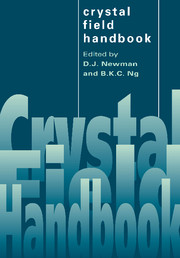Book contents
- Frontmatter
- Contents
- List of contributors
- Preface
- Introduction
- 1 Crystal field splitting mechanisms
- 2 Empirical crystal fields
- 3 Fitting crystal field parameters
- 4 Lanthanide and actinide optical spectra
- 5 Superposition model
- 6 Effects of electron correlation on crystal field splittings
- 7 Ground state splittings in S-state ions
- 8 Invariants and moments
- 9 Semiclassical model
- 10 Transition intensities
- Appendix 1 Point symmetry
- Appendix 2 QBASIC programs
- Appendix 3 Accessible program packages
- Appendix 4 Computer package CST
- Bibliography
- Index
Introduction
Published online by Cambridge University Press: 10 December 2009
- Frontmatter
- Contents
- List of contributors
- Preface
- Introduction
- 1 Crystal field splitting mechanisms
- 2 Empirical crystal fields
- 3 Fitting crystal field parameters
- 4 Lanthanide and actinide optical spectra
- 5 Superposition model
- 6 Effects of electron correlation on crystal field splittings
- 7 Ground state splittings in S-state ions
- 8 Invariants and moments
- 9 Semiclassical model
- 10 Transition intensities
- Appendix 1 Point symmetry
- Appendix 2 QBASIC programs
- Appendix 3 Accessible program packages
- Appendix 4 Computer package CST
- Bibliography
- Index
Summary
The energy spectrum of an isolated magnetic ion in a crystal carries information about the magnetic ion itself, its crystalline host and the interaction between these two components of the system. Crystal field theory comprises a range of techniques for extracting as much of this information as possible from observed spectra. The aim is to express the information in a form that can be used to predict the energy spectra of related systems.
Magnetic ions in crystals have many useful physical properties. In particular, there is an ongoing search for new types of laser crystal [Kam95, Kam96] and new magnetic materials. In order to design the new systems required for specific applications, it is necessary to be able to predict energy level structures and transition intensities for any magnetic ion in any crystalline environment. The techniques described in this book go a considerable way towards the achievement of this goal.
The term ‘crystal field theory’ has been applied to describe two quite different approaches. One of these, the so-called phenomenological approach, which involves the use of linear parametrized operator expressions to fit experimental results, provides a highly successful predictive tool. The alternative, so-called ab initio approach, in which energy levels and transition intensities are calculated from first principles, has proved far less useful. This book is mainly concerned with showing how the phenomenological approach can be used to obtain information about the physical properties of magnetic ions in crystals directly from observed spectra.
Information
- Type
- Chapter
- Information
- Crystal Field Handbook , pp. 1 - 5Publisher: Cambridge University PressPrint publication year: 2000
Accessibility standard: Unknown
- 1
- Cited by
